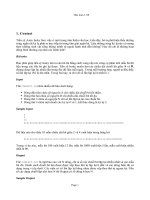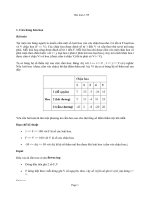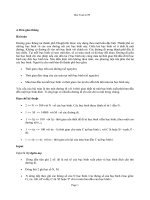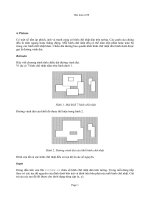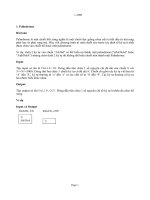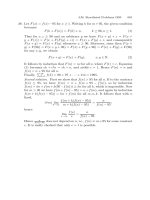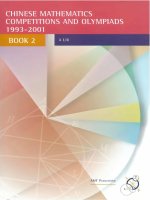Đề thi Toán quốc tế AMO năm 2018
Bạn đang xem bản rút gọn của tài liệu. Xem và tải ngay bản đầy đủ của tài liệu tại đây (445.87 KB, 5 trang )
<span class='text_page_counter'>(1)</span><div class='page_container' data-page=1>
2018 AUCKLAND MATHEMATICAL OLYMPIAD
<b>Questions</b>
• Write all your working and solutions below the question.
• You are expected to show how you obtained your solution for each question, as correct
answers (without working) will be awarded 1 mark only.
• Markers will mark only one question at a time per candidate.
<b>Junior Division </b>
<b>1. </b>
Find a multiple of 2018 whose decimal expansion's <i>first </i>four digits are 2017.<b>2. </b>
Starting with a list of three numbers, the “
<i>Make-My-Day</i>
” procedure creates a new
list by replacing each number by the sum of the other two.
For example, from {1, 3, 8} “
<i>Make-My-Day</i>
” gives {11, 9, 4} and a new “
<i></i>
<i>Make-My-Day</i>
” leads to {13, 15, 20}.
If we begin with {20, 1, 8}, what is the maximum difference between two
numbers on the list after 2018 consecutive “
<i>Make-My-Day</i>
”s?
<b>3. </b>
Consider the pentagon below. Find its area.
<b>4. </b>
A vintage tram departs a stop with a certain number of boys and girls on board.
At the first stop, a third of the girls get out and their places are taken by boys.
At the next stop, a third of the boys get out and their places are taken by girls.
There are now two more girls than boys and as many boys as there originally were
girls.
How many boys and girls were there on board at the start?
</div>
<span class='text_page_counter'>(2)</span><div class='page_container' data-page=2>
<b>Senior Division </b>
<b>6.</b>
For two non-zero real numbers
a, b ,
the equation,
𝑎𝑎(𝑥𝑥 − 𝑎𝑎)2<sub>+ 𝑏𝑏(𝑥𝑥 − 𝑏𝑏)</sub>2<sub> = 0</sub>has a unique solution.
Prove that
𝑎𝑎 = ±𝑏𝑏.<b>7.</b>
Consider a positive integer,
N = 9 + 99 + 999 + . . . + 999…9
2018
How many times does the digit 1 occur in its decimal representation?
<b>8.</b>
A rectangular sheet of paper whose dimensions are 12 x 18 is folded along
a diagonal, creating the M-shaped region drawn in the picture (see below).
Find the area of the shaded region.
<b>9.</b>
Alice and Bob are playing the following game:
They take turns writing on the board natural numbers not exceeding 2018
(to write the number twice is forbidden).
Alice begins. A player wins if after his or her move there appear three numbers on
the board which are in arithmetic progression.
Which player has a winning strategy?
<b>10.</b>
There is a sequence of numbers +1 and -1 of length
n
. It is known that the sum
of every 10 neighbouring numbers in the sequence is 0 and that the sum of every
12 neighbouring numbers in the sequence is not zero.
</div>
<span class='text_page_counter'>(3)</span><div class='page_container' data-page=3>
2018 AUCKLAND MATHEMATICAL OLYMPIAD
Solutions for Students
1 2018 × 9996 = 20171928
2 Claim: 19. In fact, the "<i>MakeMyDay</i>" procedure does not change the
maximum difference between two numbers on the list. Suppose our list is {<i>a,b,c</i>} with <i>a </i>
<i>< b < c</i>. The maximum difference between the largest and the smallest number is <i>c </i>−<i> a</i>.
The “<i>MakeMyDay</i>” operation creates {<i>b + c, a + c, a + b</i>}.
Since <i>a < b</i>, we know that <i>a+c</i> < <i>b+c</i>. Since <i>b < c</i>, we also know that <i>a+b < a+c</i>.
Combining these two inequalities, we have <i>a + b < a + c < b + c</i>.
The maximum difference between any number is (<i>b+c</i>) − (<i>a+b</i>) or <i>c − a</i>.
So the same as the one we started with. For the initial list of {20,1,8}, the maximum
difference will always be 19.
3 Inscribe in a rectangle, where ∠CBP=30deg.
Since 𝐵𝐵𝐵𝐵���� = 2, we get 𝐵𝐵𝐶𝐶���� = 1, and 𝐵𝐵𝐶𝐶���� = √3, So 𝐴𝐴𝐶𝐶�����= 1 +√3.
Then ∠DCQ = 60deg, so 𝐵𝐵𝐶𝐶���� = 1/2, 𝐶𝐶𝐶𝐶����=3/2, 𝐷𝐷𝐶𝐶���� = (√3)/2.
Finally, 𝐷𝐷𝐷𝐷���� = 1 + √3 - (√3)/2 = 2+2√3−<sub>2</sub> √3 = 1 + (√3)/2, and 𝐸𝐸𝐷𝐷�����= 1/2.
The area of the pentagon is then 𝐴𝐴𝐶𝐶���� x 𝐶𝐶𝐶𝐶���� - 1/2(𝐵𝐵𝐶𝐶����x𝐵𝐵𝐶𝐶���� + 𝐵𝐵𝐶𝐶����x𝐷𝐷𝐶𝐶���� + 𝐷𝐷𝐷𝐷����x𝐸𝐸𝐷𝐷����)
= 1/4(5+3 √3) = approx 2.549 units²
4 Let b_i and g_i be the numbers of boys and girls on board the tram, respectively,
at stop i. Note that b_0 and g_0 are the numbers of boys and girls on board the tram,
respectively, at the start of the trip.
At stop 1, b_1=b_0 + g_0/3, g_1=2 g_0/3.
Similarly, at stop 2, b_2 = 2 b_1/3, g_2 = g_1+b_1/3.
Using above formulas for b_1, g_1 leads to b_2 = 2b_0/3 + 2g_0/9,
g_2 = 7g_0/9 + b_0/3. From b_2 = g_0 this yields b_0 = 7g_0/6.
As b_2+2 = g_2, we have g_0 = 1/5(3b_0+18).
We can now solve for g_0 to get g_0=12 and then b_0=14.
5 We have <i>b </i>≤<i> a</i>+1, <i>c </i>≤<i> b</i>+1, <i>a </i>≤<i> c</i>+1, so that <i>c</i>-1 ≤<i>b </i>≤<i> a</i>+1 ≤<i>c</i>+2,
so <i>a</i> in {<i>c</i>-2, <i>c</i>-1, <i>c</i>, <i>c</i>+1}. Now a case bash yields 10 solutions:
</div>
<span class='text_page_counter'>(4)</span><div class='page_container' data-page=4>
6 Suppose a and b are both positive. Then 𝑎𝑎(𝑥𝑥 − 𝑎𝑎)2 <sub>≥</sub><sub>0</sub><sub> and </sub><sub>𝑏𝑏</sub><sub>(</sub><sub>𝑥𝑥 − 𝑏𝑏</sub><sub>)</sub>2<sub> </sub><sub>≥</sub> <sub>0</sub>
with the first being zero for x = a and the second being zero for x = b.
Thus 𝑎𝑎(𝑥𝑥 − 𝑎𝑎)2<sub>+</sub><sub>𝑏𝑏</sub><sub>(</sub><sub>𝑥𝑥 − 𝑏𝑏</sub><sub>)</sub>2<sub> = 0</sub><sub> only when x = a = b. </sub>
If a and b are both negative, then the reasoning is similar.
If a and b have opposite signs, we rewrite the equation as follows:
𝑎𝑎(𝑥𝑥 − 𝑎𝑎)2<sub>+</sub><sub>𝑏𝑏</sub><sub>(</sub><sub>𝑥𝑥 − 𝑏𝑏</sub><sub>)</sub>2<sub> = </sub><sub>(</sub><sub>𝑎𝑎</sub><sub>+</sub><sub>𝑏𝑏</sub><sub>)</sub><sub>𝑥𝑥</sub>2<sub>−</sub><sub>2(</sub><sub>𝑎𝑎</sub>2<sub>+</sub><sub>𝑏𝑏</sub>2<sub>)</sub><sub>𝑥𝑥</sub><sub>+ (</sub><sub>𝑎𝑎</sub>3 <sub>+ </sub><sub>𝑏𝑏</sub>3<sub>) = 0</sub>
Then its discriminant, D = 4(𝑎𝑎2<sub>+</sub><sub>𝑏𝑏</sub>2<sub>)</sub>2 <sub>−</sub><sub> 4(</sub><sub>𝑎𝑎</sub><sub>+</sub><sub>𝑏𝑏</sub><sub>)(</sub><sub>𝑎𝑎</sub>3<sub>+ </sub><sub>𝑏𝑏</sub>3<sub>)</sub>
= 4(2𝑎𝑎2<sub>𝑏𝑏</sub>2 <sub>−</sub><sub> </sub><sub>𝑎𝑎𝑏𝑏</sub>3<sub>−</sub> <sub>𝑏𝑏𝑎𝑎</sub>3<sub>)</sub>
= −4𝑎𝑎𝑏𝑏(−2𝑎𝑎𝑏𝑏+ 𝑏𝑏2<sub>+ </sub><sub>𝑎𝑎</sub>2<sub>)</sub>
= −4𝑎𝑎𝑏𝑏(𝑎𝑎 − 𝑏𝑏)2<sub> < 0</sub><sub>, is negative unless </sub><sub>𝑏𝑏</sub><sub>= </sub><sub>−𝑎𝑎</sub><sub>.</sub><sub> </sub>
7 We have
N = (10−1) + (102<sub>−</sub><sub>1) +</sub><sub>⋯</sub><sub>+ (10</sub>2018<sub>−</sub><sub>1)</sub><sub> = </sub><sub>111 … 10 </sub><sub>−</sub><sub> 2018</sub>
2018
= 111 … 100000 + (11110− 2018)
2014
= 111 … 100000 + 9092.
2014
Hence in decimal representation there are 2014 ones.
8 The area of the M-region is area
of rectangle ABCD - area ∆𝐴𝐴𝐵𝐵𝐸𝐸
as triangle ∆𝐴𝐴𝐵𝐵𝐸𝐸 is the overlap.
|ABCD| = 12 x 18 = 216.
𝐴𝐴𝐵𝐵
���� is the diagonal of the
rectangle,
so 𝐴𝐴𝐵𝐵����= √122<sub>+ 18</sub>2<sub> </sub>
= 6√13.
The height of ∆𝐴𝐴𝐵𝐵𝐸𝐸 is 𝐸𝐸𝐸𝐸����,
and equals 𝐸𝐸𝐵𝐵���� x tan ∠𝐷𝐷𝐴𝐴𝐵𝐵
|𝐸𝐸𝐵𝐵����| = 3√13
and tan ∠𝐷𝐷𝐴𝐴𝐵𝐵 = 12<sub>18</sub> = 2<sub>3</sub>
So |∆𝐴𝐴𝐵𝐵𝐸𝐸| = 1<sub>2</sub>|𝐴𝐴𝐵𝐵����| x |𝐸𝐸𝐸𝐸����| = 78.
Area = 216-78 = 138.
<b>OR . . . </b>
With ∆𝐴𝐴𝐷𝐷𝐵𝐵 = half
rectangle 𝐴𝐴𝐵𝐵𝐵𝐵𝐷𝐷= 108
then remaining shaded
area = ∆𝐴𝐴𝐵𝐵𝐸𝐸,
and since side 𝐴𝐴𝐵𝐵���� = 12,
we can find 𝐵𝐵𝐸𝐸���� from 12 ×
tan (∠𝐵𝐵𝐴𝐴𝐸𝐸),
where ∠𝐵𝐵𝐴𝐴𝐸𝐸 is from
∠𝐵𝐵𝐴𝐴𝐵𝐵 − ∠𝐷𝐷𝐴𝐴𝐵𝐵
(i.e. from
𝑡𝑡𝑎𝑎𝑡𝑡−1<sub>�</sub>18
12� − 𝑡𝑡𝑎𝑎𝑡𝑡−1�
12
18�)
So 𝐵𝐵𝐸𝐸���� = 5,
and smaller ∆𝐴𝐴𝐵𝐵𝐸𝐸 = 30, so
combined shaded area of
∆𝐴𝐴𝐷𝐷𝐵𝐵+ ∆𝐴𝐴𝐵𝐵𝐸𝐸
= 108 + 30 = 138.
<b>OR . . . </b>
We have
𝐴𝐴𝐸𝐸
���� (= 𝐸𝐸𝐵𝐵����) + 𝐸𝐸𝐷𝐷���� = 18,
so set up the equation
with 𝐸𝐸𝐷𝐷���� = 𝐸𝐸𝐵𝐵���� = 𝑥𝑥
so that
𝑥𝑥2<sub>+ 12</sub>2 <sub> = </sub><sub>(18</sub><sub>− 𝑥𝑥</sub><sub>)</sub>2<sub> </sub>
144 = 324−36𝑥𝑥
Solves 𝑥𝑥 = 5 =𝐸𝐸𝐷𝐷����.
Therefore the shaded
area
= 1<sub>2</sub> (12 x 18) + 1<sub>2</sub> (5 x 12)
</div>
<span class='text_page_counter'>(5)</span><div class='page_container' data-page=5>
9 If after her second move Alice does not win, then Bob wins with his second move.
Indeed, in this case there are two numbers <i>a</i> and b on the board with the same parity.
Bob wins with writing 1<sub>2</sub>(𝑎𝑎+𝑏𝑏).
We just need to show how Bob chooses his first move.
If Alice chooses 𝑎𝑎 ≤ 1009 , then Bob chooses the number in the set {2017, 2018}
whose parity is different from <i>a</i>.
And, if Alice chooses 𝑎𝑎 ≥1010, then Bob chooses <i>b</i> = 1 or 2, the one whose parity is
different from <i>a</i>.
Then Alice cannot win with her second move since 1<sub>2</sub>(𝑎𝑎+𝑏𝑏) is not an integer.
10 Firstly, let us show that <i>n</i> = 15 is possible. Indeed, we can have the sequence
+1 + 1 + 1 + 1 + 1 - 1 - 1 - 1 - 1 - 1 + 1 + 1 + 1 + 1 + 1:
Let us prove that <i>n</i> cannot be larger.
Suppose 𝑡𝑡 ≥ 16 and our sequence is 𝑥𝑥 = 𝑥𝑥1𝑥𝑥2𝑥𝑥3… 𝑥𝑥𝑛𝑛.
Without loss of generality suppose 𝑥𝑥1 = 1.
Then, as the sum of every 10 neighbouring numbers is 0, we have 𝑥𝑥11 = 1.
Thus we have 𝑥𝑥 = 1𝑥𝑥2𝑥𝑥3…𝑥𝑥101𝑥𝑥12𝑥𝑥13…𝑥𝑥𝑛𝑛.
We claim that 𝑥𝑥12 = … = 𝑥𝑥𝑛𝑛 = 1.
Indeed, among these, -1 cannot follow 1 since then we will have the sum of 12
consecutive terms of the sequence, which ends with these +1 and -1 being 0.
If 𝑡𝑡 ≥ 16, then we have at least 6 ones at the end of the sequence which it then makes
</div>
<!--links-->
